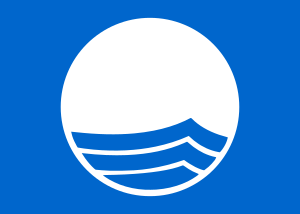Blue Flag beach facts for kids
The Blue Flag is a special award given to beaches and marinas around the world. It means these places are super clean, safe, and good for the environment. Think of it like a gold star for beaches! When a beach gets a Blue Flag, it shows that it meets high standards for things like water quality, safety, and teaching people about protecting nature. Local governments often try hard to get this award for their beaches. It helps them show visitors that their beaches are top-notch and care about the environment.
The Blue Flag is a special symbol owned by the Foundation for Environmental Education (FEE). FEE is a group that works to protect the environment. It is made up of 65 organizations in 60 different countries. These countries are in Europe, Africa, Oceania, Asia, and the Americas.
How Blue Flags are Awarded
FEE calls the Blue Flag certificates "awards." They are given out for one year at a time to beaches and marinas in countries that are part of the FEE group. The awards are announced at different times of the year. For places like Europe, Canada, and Morocco, the awards are announced on June 5th. For places like the Caribbean, New Zealand, and South Africa, they are announced on November 1st.
Countries with Blue Flag Beaches
Many countries around the world have beaches and marinas that have earned the Blue Flag award. Currently, 41 countries are part of the Blue Flag Programme. These include:
- Aruba
- Bahamas
- Belgium
- Brazil
- Bulgaria
- Canada
- Chile
- Croatia
- Cyprus
- Denmark
- Dominican Republic
- Finland
- France
- Germany
- Greece
- Iceland
- Ireland
- Italy
- Jamaica
- Latvia
- Lithuania
- Malta
- Montenegro
- Morocco
- Netherlands
- New Zealand
- Norway
- Poland
- Portugal
- Puerto Rico
- Russia
- Romania
- Slovenia
- South Africa
- Spain
- Sweden
- Tunisia
- Turkey
- United Kingdom
- United Arab Emirates
Images for kids
-
Blue Flag beach in Malia, Crete, Greece
See also
 In Spanish: Bandera Azul para niños
In Spanish: Bandera Azul para niños




